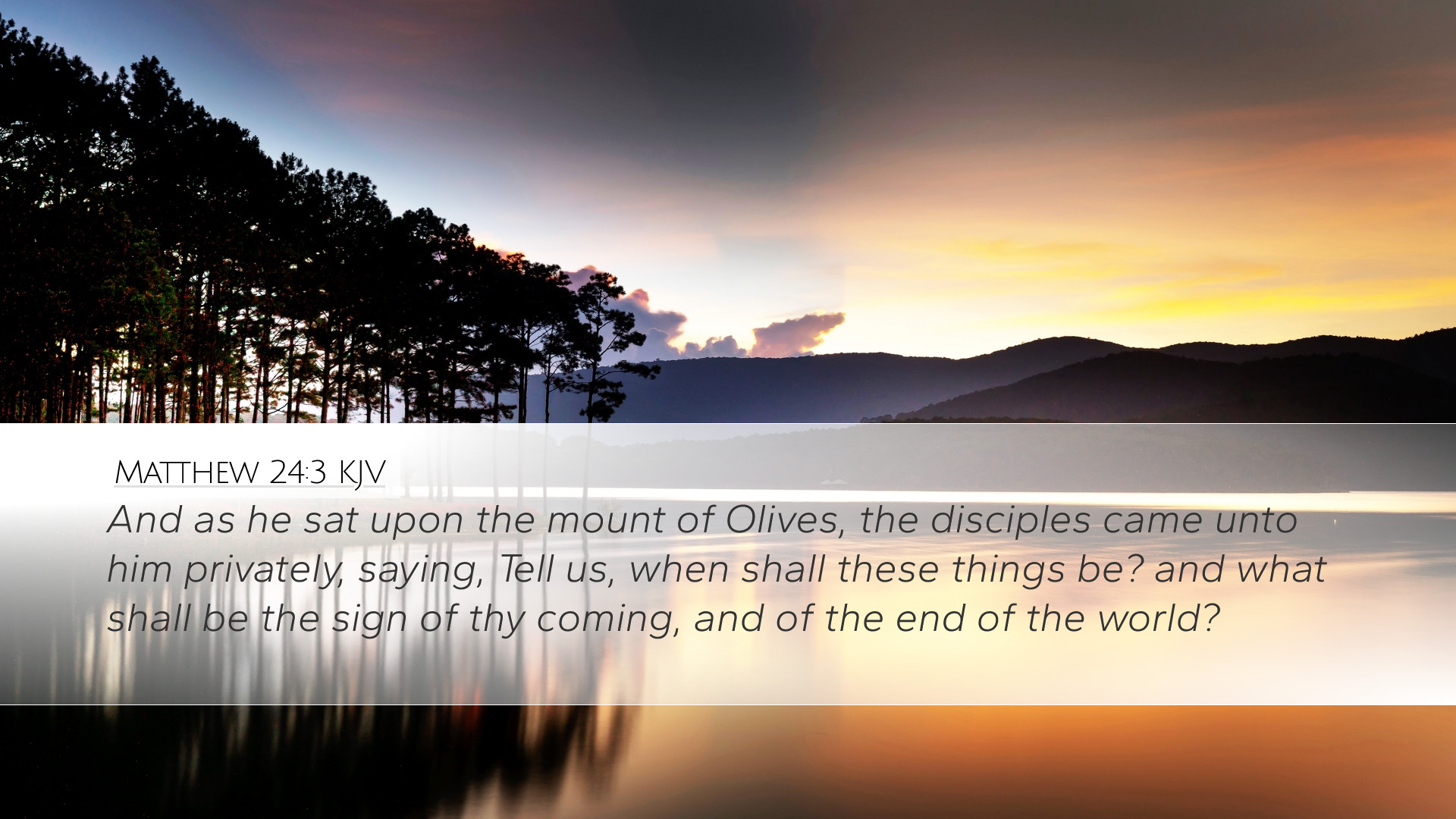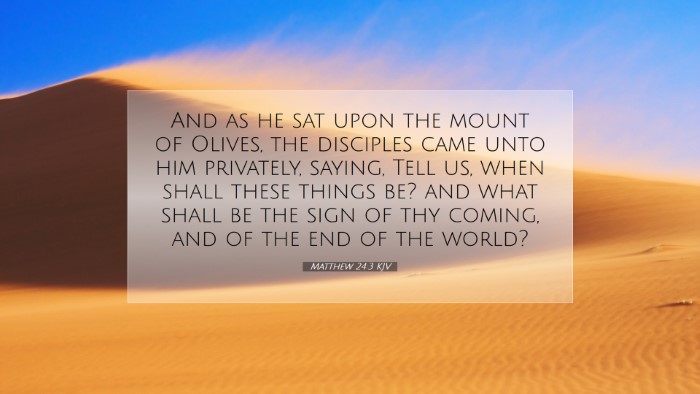Commentary on Matthew 24:3
Verse Context: Matthew 24:3 states, "As he sat upon the mount of Olives, the disciples came unto him privately, saying, Tell us, when shall these things be? and what shall be the sign of thy coming, and of the end of the world?" This verse marks a significant moment in the Gospel of Matthew, where Jesus’ teaching transitions towards eschatological themes.
Overview and Historical Context
The setting of this verse is the Mount of Olives, a place of solace and reflection for Jesus, and a location rich with prophetic significance. The disciples' inquiry reflects their concern about the future, specifically regarding the destruction of the temple and the signs of the end of the age. This moment is pivotal, as it transitions from the immediate context of the Jewish nation to broader eschatological concerns.
Disciples Inquire Privately
The choice of the disciples to approach Jesus privately (as noted by the word "privately") indicates a desire for understanding that is deeper than what might have been communicated to the public. This private discourse exemplifies the intimacy of their relationship with Christ and signifies their earnestness to grasp the weighty matters he alluded to during prior teachings.
Insights from Commentators
-
Matthew Henry:
Henry comments on the disciples' approach, noting that their questions reflect a longing to comprehend the times and seasons, which is a natural inclination for believers who yearn to grasp divine purposes in unfolding history. He emphasizes that their inquiry reveals their faith, as they seek validation of Christ's authority to teach on such profound themes.
-
Albert Barnes:
Barnes emphasizes the nature of the questions posed by the disciples—reflecting their curiosity about the future events that would unfold concerning the temple's destruction and the coming of Christ. He notes that the structure of their inquiries demonstrates an interconnectedness of the events: the destruction of the temple, the return of Christ, and the culmination of the age.
-
Adam Clarke:
Clarke interprets "the end of the world" with deeper theological reflection, suggesting that the term refers not merely to the physical cessation of the earth but to a transformative period ushering in God’s ultimate plan. He clarifies that the understanding of eschatological events requires an interpretation framed by faith and rooted in the Old Testament prophecies, which the disciples would have been familiar with.
Theological Significance
This passage serves as a precursor to a series of prophetic teachings by Jesus concerning the end times. It signals the beginning of a discourse on the nature of God’s kingdom, the trials that believers will face, and the overarching sovereignty of God in the face of chaos and uncertainty. This call to understanding the signs of the times is critical for pastoral teaching, as it confronts modern believers with both present-day realities and eternal truths.
Key Themes for Reflection
- The Importance of Inquiry: The disciples embody an imperative for all believers to seek understanding of divine truths. This desire for knowledge represents an active engagement in faith which is necessary for spiritual maturity.
- The Nature of Prophecy: Jesus’ teachings here establish a foundation for understanding biblical prophecy. His insights on the end times are instructional, meant to prepare hearts and minds for the realities of faith amidst trials.
- Eschatological Awareness: The tension between present suffering and future hope is a theme woven throughout Scripture. The urgency of the disciples’ questions invites believers to cultivate an awareness of God’s redemptive work in history.
Application for Today
For pastors and theologians, Matthew 24:3 encourages a robust engagement with eschatological teachings. The question of “when” and “what signs” are vital for understanding the broader narrative of Scripture in relation to present-day events and challenges. Furthermore, this passage implores believers to remain vigilant, informed, and faithful, as they navigate their spiritual journeys.
As we analyze this inquiry, it is crucial to recognize that while the disciples sought specific signs, Jesus ultimately redirects their focus towards preparedness and vigilance over mere speculation. This invites contemporary Christians to reflect on their posture towards the second coming of Christ, ensuring it is grounded in hope rather than fear.
Conclusion
Matthew 24:3 stands as a powerful reminder of the intersection between the immediate and the eternal. Through historical inquiries and theological insights, it calls for an understanding that transcends mere curiosity. As believers engage with this text, they are urged to seek comprehensive knowledge of God’s plans while embodying a faith that is ready for His return.


